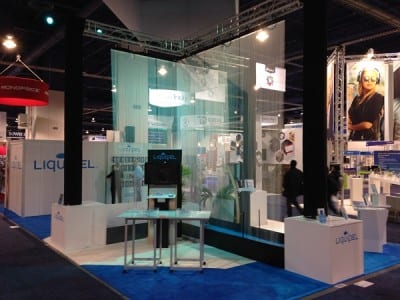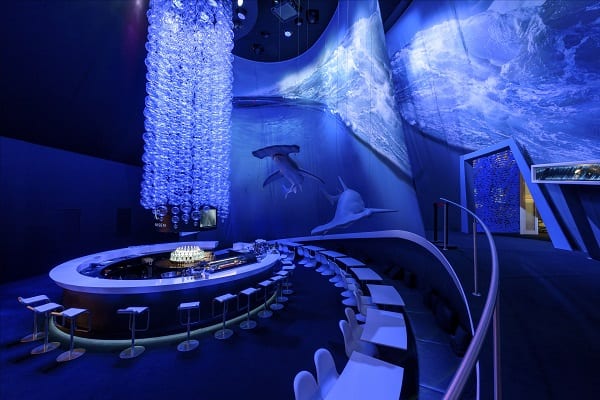Water features are some of the most purposely used elements in exhibit design. Never does it seem to be utilized without rhyme or reason due to the challenges of its intangible nature.
Unlike solid exhibit material, liquid slips away. Fluid leaks easily from accidentally punctured containers during transportation or installation. This could spell disaster on the show floor, especially if it leaks through carpet that is covering essential wires. (Tip: Use laminate flooring!)
Surprisingly, there are few regulations about using water elements as part of exhibit design in the U.S., as demonstrated by the experience of SPOON Exhibits & Events. On the other hand, water features could be regulated on a venue-by-venue, show management-by-show management or country-by-country basis.
No need to fear. Using water features carefully and correctly can be a smooth in and out. Water features need maintenance just like any other moving part on the show floor, according to Orrie Capone, vice president at SPOON Exhibits & Events.
Although unlike some other moving parts, water optimizes the design message, which designers and creative directors readily welcome. It underscores a brand or product and complements an overarching theme.
As an uncommon sight on the show floor, water is an instant draw that also pleases exhibitors and attendees due to its cool, refreshing, reviving nature.
SPOON Exhibits & Events – Liquipel
With a brand like Liquipel, it was obvious to SPOON Exhibits & Events that a 16-foot high water wall suited its client’s 30’ x 50’ exhibit at 2014 International CES. The only challenge was smoothly getting it into the Las Vegas Convention Center.
“Water and fire inside buildings are not easy tasks to replicate. I think everyone on the practical side of the industry sees challenges bringing water and fire into buildings,” stated Orrie Capone, vice president, SPOON Exhibits & Events. “Everything transported in has to be self-contained, and you have to make sure nothing affects the foundations of the venue. There is always concern with assets, such as how they are handled by transportation companies.”
 A small water tank emphasized that the chemical process Liquipel, created to protect mobile devices, works. Smartphones sunken in the tank survived to be used again thanks to the chemical protectant. While this was an interesting demonstration, the water wall garnered the most attention.
A small water tank emphasized that the chemical process Liquipel, created to protect mobile devices, works. Smartphones sunken in the tank survived to be used again thanks to the chemical protectant. While this was an interesting demonstration, the water wall garnered the most attention.
“The water wall started below Liquipel’s hanging sign, bringing you right in. It will get your attention wherever you are,” explained Capone. “Part of it was luck for [Liquipel] getting that location on the show floor. Las Vegas Convention Center is a good environment to get access to water and drainage ports.”
Because the water wall proved powerful in attracting attendees, SPOON’s staff spread out the exhibit’s custom elements to give them space to shine. This was made easier due to the sheer size of the exhibit.
“You have to make sure the booth space is big enough to use a water wall effectively. You need to make sure you have a 20’ x 20’ or 20’ x 30’. I typically recommend a 30’ x 40’ or 30’ x 50’,” added Capone.
SPOON successfully maintained flow in terms of the exhibit layout and by cleaning the water wall’s nozzles after each show day. Additionally, the exhibit house furthered Liquipel’s goal to help attendees understand its product.
No waterworks from IWC Schaffhausen
IWC Schaffhausen, an international fine watchmaker with an in-house design department, pulled off a 1,000 square meter underwater themed exhibit despite venue regulations prohibiting the use of water features.
Palexpo Geneva Congress Center in Switzerland doesn’t allow the use of water displays. This is due to the under the show floor location of a technical basement and the need to avoid accidentally damaging expensive equipment, according to IWC Associate Director of Strategic Planning Christoph Grainger-Herr.
Also a concept designer, Grainger-Herr transformed his company’s exhibit with 3D projections of 18,000 images of the Galapagos Islands, which inspired IWC’s Aquatimer watch collection. Sophisticated lighting, a 30-foot long chandelier made of more than 2,000 Plexiglas bubbles and faux hammerhead sharks hanging from the ceiling added to the presentation at 2014 Salon International de la Haute Horlogerie, an annual private event for luxury watchmakers.
Each year, IWC designs luxury exhibits in-house but hires an outside company for the build. Its past designs include Formula 1 racing and airplane themed exhibits.































